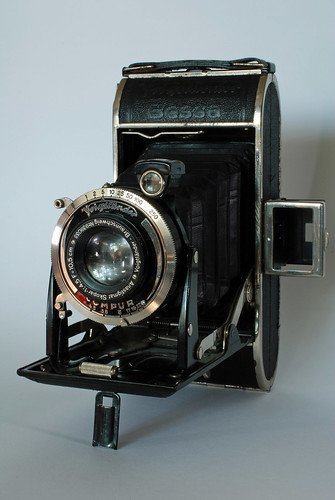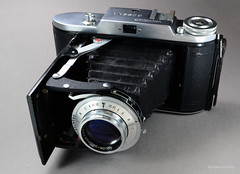Bessa (folders)
The Bessa folders were part of a range of Bessa cameras produced in Germany by Voigtländer over a long period. Voigtländer is rather famous for reusing and recycling trademarks and camera names. For example, there are various "Bessa" models out there that are in no way similar to the pre-World War II Bessa.
Bessa

|
| 1930s Bessa with f/4.5 Skopar and Compur shutter image by Dietmar Schwanitz (Image rights) |
The Bessa folder was the first production model of the Bessa line, produced between 1929 and 1956. It is a medium-format folder that uses 120 film to produce 6×9cm or, in some versions with the use of a frame mask, 4.5×6cm photographs. It is the best known and the best selling of all the Voigtländer cameras; it is estimated that as many as 575,000 of the folders were made. The first self-erecting folder offered by Voigtländer, the Bessa was produced with four different lens types: Voigtar, Vaskar, Skopar, and the Color Skopar. There were also three shutter options: Prontor, Compur, and Compur Rapid. Identifying which options are present in the camera is usually done by inspecting the inner lens ring and the outer lens ring, or by year of production.
Bessa Production variations by year
- 1929-1949. Self-erecting rollfilm camera. Similar to the Rollfilm. There were many sizes and modifications. All models are priced about the same.
- 1929: 6x9, brilliant finder;
- 1930: 6x9 and 6.5x11, brilliant and folding finders;
- 1932: 3.4x5.5 and 6x9, lens on rails, replacement to Inos;
- 1935: 4.5x6 and 6x9, shutter release on door;
- 1937: 4.5x6 and 6x9, finder with cover;
- 1945: same as 1937, some models had sync;
- 1949: similar to 1937, better shutters.
An eye-level sports finder is located in the top of the camera (the top when held horizontally), folded under a metal hood in some models. In some models, the front frame of the finder has a negative lens. Bessas produced after 1930 also have a brilliant finder.
Voigtländer offered a few accessories or optional equipment for the Bessa line: a simple cable release, a brilliant-finder magnifier, and an "Alpha" yellow filter.
Bessa I

|
| Voigtländer Bessa I image by Hans Kerensky (Image rights) |
The Bessa I was manufactured from 1951 until 1956 (about 80,000 units) and is a well made camera that uses 120 film and can give either 6x4.5cm (with insert) or 6x9cm negatives. The Bessa I has a simple finder that lacks a built-in rangefinder; however, it is possible to use a small external rangefinder that mounts in the shoe on the top, which in practice is easy to use--simply transfer the distance to the lens.
- Shutter/Lens Combinations:
- Vaskar 1:4.5/105mm (coated) in a Pronto, Prontor-S or Prontor-SV leaf shutter
- Color-Skopar 1:3.5/105mm (coated) in a Prontor-S, Prontor-SV or Prontor-SVS leaf shutter
- Filter size: push-on 37mm
- Viewfinder: optical direct-vision viewfinder with four different masks, two formats (6x9 and 4.5x6), and two parallax corrections (1 meter, close-up) separate for each format
- Dimensions (folded) : 168x98x48mm
- Weight : 770 grams
Bessa II

|
| Bessa II 1956 image by Geoff Harrisson (Image rights) |
This is the most renowned of the cameras with the "Bessa" name. It is a self folding camera with a coupled rangefinder. Thirty-four thousand five hundred Bessa IIs were made from 1950 to 1956. They were fitted with a Color-Skopar 3.5/10.5cm; a Color-Heliar 3.5/10.5cm; or, from 1954, the rare and sought-after Apo-Lanthar 4.5/10.5cm. The Compur-Rapid shutter fitted on the earlier models was replaced by the Synchro-Compur shutter from 1951. The accessory shoe appears only from 1954.
Bessa RF (1936-1951)

|
| Voigtländer Bessa RF image by THE LAST PHOTOGRAPHIES (Image rights) |
The Bessa RF camera had a very long life and is the predecessor of the Bessa II. It is an improved version of the Bessa 1935 model, but with a coupled rangfinder. All models have a 1/400 Compur-Rapid shutter but can be fitted with four different lenses:
- Skopar 3.5/10.5cm
- Heliar 3.5/10.5cm
- Helomar 3.5/10.5cm
- Color-Heliar 3.5/10.5cm
Like several Bessas it makes 6x9 or 4.5x6 exposures on 120 film and has a shutter release on the front door. Sixty thousand of the Bessa RF were made.
Bibliography
- Claus Prochnow, Voigtländer Report 3, First edition, Braunschweig (D), Lindemanns Verlag, 2007, ISBN 978-3-89506-274-2.
Links
In English:
- Bessa I and Bessa II folding cameras at antjam65's site (archived)
- Bessa I repair notes at Robert Ian Axford's Camera Works
- Bessa, Bessa II, and Bessa 66 at The Classic Camera (archived)
- Bessa by Roger W. Hicks, among Shutterbug's Classic & Historical Cameras
- Bessa I and II at Jurgen Kreckel's site
- Bessa models (very well illustrated), at UK Camera (archived)
- Bessa instruction manual from www.orphancameras.com
In French:
- Bessa 66 at M. Groleau's site
- Bessa before 1935 at www.collection-appareils.fr by Sylvain Halgand
- Bessa II at www.collection-appareils.fr by Sylvain Halgand
In Japanese:
- Bessa at Camera Asobi Room (archived)
In Polish:
- Voigtek at www.stegierski.com by Rafał Stęgierski